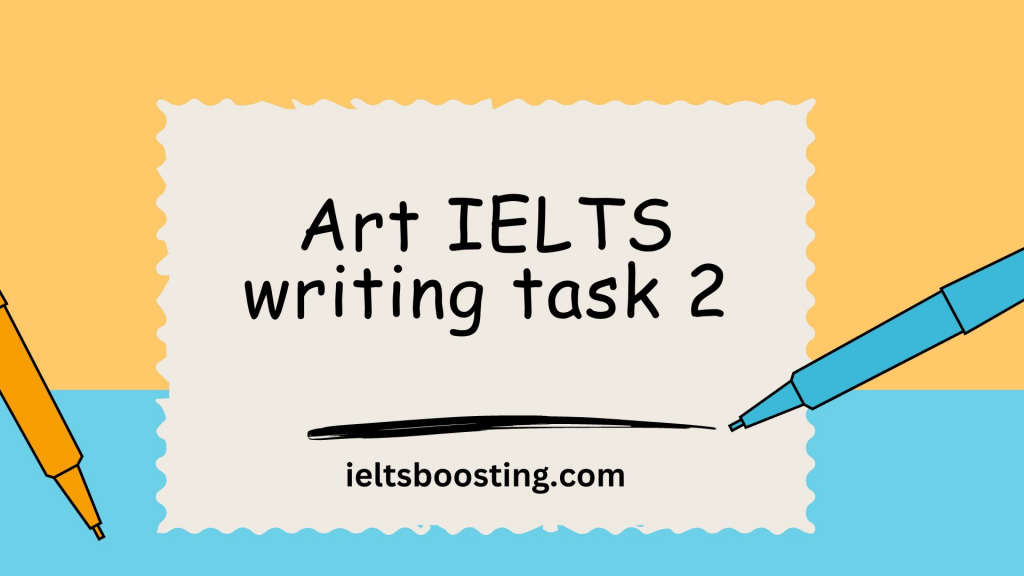Art ielts writing task 2
Some people think that art should be taught in schools. Others believe that it is a waste of time and resources. Discuss both views and give your own opinion.
| Benefits of Teaching Art in Schools | Counterarguments Against Teaching Art in Schools |
|
Art Education Provides Students with a Well-Rounded Education That Includes Creative and Expressive Skills Reason: Art education fosters creativity and self-expression, complementing the academic skills learned in other subjects. This combination ensures students develop both intellectually and emotionally. Example: students involved in art projects may demonstrate improved emotional intelligence and creativity, which are crucial for personal and professional development. Result: Students who receive a well-rounded education that includes art are more likely to become well-adjusted individuals with diverse skills and perspectives. |
Resources for Art Education Can Be Limited and Expensive
Reason: Allocating resources to art education can be costly, requiring funds for supplies, equipment, and specialized teachers. This financial burden may divert funds from other critical subjects. Example: A school facing budget constraints might have to choose between purchasing new science lab equipment or funding an art program. Prioritizing art education could mean fewer resources for subjects that are seen as more directly linked to academic achievement and career readiness. Result: As a consequence, important subjects like math and science may suffer from underfunding, potentially impacting the quality of education in these areas. |
| Art Classes Can Be a Way for Students to Explore Their Interests and Develop Their Passions
Reason: Art classes offer students the opportunity to discover and nurture their talents and interests that might not be evident in other subjects. Example: A student who excels in visual arts may find their passion through painting or drawing classes, leading them to pursue a career in graphic design or fine arts. Result: By exploring their interests in art classes, students can develop lifelong passions and career paths that are fulfilling and rewarding. |
Some People Believe That Art Education Is Not Essential for Students to Succeed in Life and Their Careers
Reason: There is a perception that art education does not directly contribute to essential life skills or career success, especially in a job market that highly values technical and practical skills. Example: Employers in fields such as engineering, finance, and healthcare often prioritize candidates with strong backgrounds in STEM subjects over those with artistic skills. Result: This belief can lead to a de-emphasis on art education, with schools focusing more on subjects that are traditionally seen as more beneficial for future employment. |
| Art Can Help Students to Develop Critical Thinking and Problem-Solving Skills That Can Be Applied in Other Areas of Their Lives
Reason: Engaging in artistic activities requires students to think creatively, solve problems, and make decisions, skills that are transferable to other academic and life situations. Example: A student working on a complex art project must plan, execute, and adapt their approach, which enhances their ability to tackle challenges in subjects like science or math. Result: Students who develop critical thinking and problem-solving skills through art are better equipped to handle academic and real-world challenges, leading to overall success. |
Time Spent on Art Classes Could Be Better Used for Other Subjects That Are Seen as More Important, Such as Maths or Science
Reason: Time is a limited resource in education, and there is a need to prioritize subjects that have a more direct impact on academic success and standardized test scores. Example: A school might reduce art classes to allocate more time for math and science lessons in order to improve students’ performance on standardized tests and meet educational benchmarks. Result: This focus can lead to improved test scores and academic performance in core subjects, but it may also result in a less balanced education that neglects the development of creativity and self-expression. |
| Art Can Promote Cultural Understanding and Appreciation for Different Perspectives
Reason: Art education exposes students to various cultures and historical contexts, fostering an appreciation for diversity and multiple viewpoints. Example: Learning about different art forms from around the world helps students understand and respect cultural differences, promoting empathy and global awareness. Result: This cultural understanding contributes to creating a more inclusive and respectful school environment and prepares students to thrive in a diverse society. |
Art Classes May Not Appeal to All Students, and Some May Feel Forced to Participate in Something They Have No Interest In
Reason: Not all students are interested in or have a talent for art, and mandatory art classes can feel like a burden to those who do not enjoy them. Example: A student who excels in math and science but has no interest in art may feel frustrated and disengaged when required to take art classes, potentially affecting their overall school experience and performance in other subjects. Result: Forcing uninterested students to participate in art classes can lead to disengagement and a negative attitude towards school, rather than fostering a positive and inclusive learning environment. |
| Art Classes Can Provide a Sense of Community and Belonging for Students Who May Not Excel in Traditional Academic Subjects
Reason: Art classes offer a platform for students who may struggle in other academic areas to shine, fostering a sense of achievement and belonging. Example: A student who finds it difficult to excel in subjects like math or science may discover their strengths in art, boosting their confidence and self-esteem. Result: By participating in art classes, these students feel valued and included, which enhances their overall school experience and promotes a positive attitude towards learning.
|
The Value of Art Is Subjective and Varies from Person to Person, Making It Difficult to Measure Its Impact on Student Success
Reason: Unlike subjects with clear metrics for success, such as math and science, the impact of art education is more subjective and harder to quantify. Example: While one student might find profound personal and emotional growth through art, another might see it as a less important part of their education with little tangible benefit. Result: The subjective nature of art makes it challenging to justify its inclusion in a curriculum that is increasingly focused on measurable outcomes and standardized achievements. This can lead to debates about the allocation of time and resources for art education in schools. |
In recent years, street art has become increasingly popular in many cities around the world. Some people consider it a form of vandalism, while others see it as a legitimate form of artistic expression. What is your opinion on this?
Cách viết mở bài writing task 2
| Arguments in favour of street art | Arguments against government funding for the arts |
| Street Art Can Bring Colour and Life to Otherwise Drab and Uninteresting Public Spaces
Reason: Street art can transform bland, grey urban areas into vibrant and engaging environments that attract attention and bring joy to residents and visitors. Murals and graffiti can brighten up walls, underpasses, and other neglected spaces, turning them into local landmarks. |
Street Art Can Be Seen as Vandalism or Defacement of Public Property Reason: Street art, especially when done without permission, is often viewed as an illegal act of vandalism. Property owners and city officials may see it as damaging to buildings and public spaces. Example: In many cities, graffiti on public transportation, buildings, or monuments is considered a criminal offense. For instance, in HCMC ….. Result: This perception of street art as vandalism can lead to legal consequences for the artists, as well as negative reactions from the community who may see the artwork as a violation of their environment rather than a beautification effort. |
| Street Art Can Be a Form of Public Art That Is Accessible to Everyone, Regardless of Their Socioeconomic Status
Reason: Unlike traditional art galleries and museums, which may charge admission fees or be located in exclusive areas, street art is free and available to anyone who passes by. Result: This accessibility helps democratize art, making it an inclusive experience that can be enjoyed by a diverse audience. |
Street Art Can Be Offensive or Inappropriate
Reason: Not all street art is created with the intention of beautifying or positively impacting the community. Some pieces may include profanity, hate speech, or other forms of objectionable content, which can be offensive to the public. Example: For example, graffiti that includes offensive language or symbols might need to be removed immediately to maintain public decency. Result: Offensive street art can cause distress and division among community members, undermining the potential positive impact of public art and leading to calls for stricter regulations and enforcement against unauthorized street art. |
| Street Art Can Be Used to Convey Political or Social Messages That Might Not Otherwise Be Heard or Seen
Reason: Street art provides a platform for artists to express political and social viewpoints, raising awareness about important issues in a public and accessible manner. |
Street Art Can Be Expensive to Remove or Clean Up
Reason: When street art is created using permanent materials like spray paint, it can be costly and labor-intensive to remove, putting a financial burden on property owners and local governments. Result: These expenses can strain municipal budgets and divert funds from other important public services, such as education, healthcare, and infrastructure maintenance. Additionally, the repeated need to clean up graffiti can create frustration and resentment among property owners and taxpayers. |
Many people argue that government funding for the arts is a waste of money. To what extent do you agree or disagree with this viewpoint?
| Arguments for Government Funding for the Arts | Arguments again Government Funding for the Arts |
Cultural Enrichment:
|
Priority of Essential Services:
|
Economic Benefits:
|
Private Sector Support:
|
Educational Value:
|
Subjective Value of Art:
|
Tham gia nhóm gia sư IELTS để luyện tiếng Anh nhé


